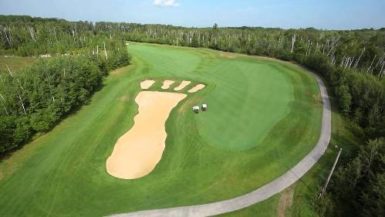He’s never at a loss for words, never wanting for a laugh, never lacking a story and never ceases to berate himself with self-deprecating humor. Boston golf course architect Brian Silva calls himself a “golf artichoke.” If he means infinite layers, depth, complexity and great taste, then the analogy is perfect.
Silva is only 5’7″ in spikes. He stridently laments that “my courses are not designed for short, old fat guys like me,” but don’t let him fool you. He bicycles 25 miles every day, walks the course with the energy of a college student and rarely misses a fairway. He quotes Caddyshack with the vigor and delight of a cart boy. In fact, a round with Silva is a steady stream of witty observations, banter, and jokes. One could momentarily forget he was the celebrated favorite son of New England golf, a multiple award winning designer, a renovator of U.S.G.A. sites, a professor of golf history and a genius of strategic design. But despite the humility of a blue-collar Bostonian and the humor of a teasing college buddy, Silva takes golf course architecture to its most complex level, challenging golfers to think their way around courses filled with strategic options and nuanced design features.
Silva designs are a refreshing and inimitable blend of design concepts of old masters like Seth Raynor and C.B. Macdonald. Using random geometric shaped bunkers, hazards turned perpendicular to the line of play, and varied green complexes such as Biarritzes and punchbowls mixed with modern twists he invented such as vertically stacked bunkers, he sends straightforward, parkland-style golf-loving traditionalists into apoplectic confusion. It’s needed. For too long, American golfers have thought a “redan” was a pterodactyl that fought Godzilla and that a “Biarritz” was a ’79 Oldsmobile. Yet Silva designs are not just an artistic exercise, but a history lesson, an architecture lesson, a non-stop run of surprises and perhaps the most fun one can have in four and a half hours while vertical.
The road to a landmark career was a lifelong journey. Silva first rode the bulldozers building a golf course at age three on his father’s lap while Silva, Sr. shaped courses for Boston architect Geoffrey Cornish. At Cornish’s recommendation, Silva got a degree in turf management from Stockbridge School of Agriculture and a Masters in Plant and Soil Sciences from UMass, then taught agronomy at a community college in Florida before returning to Massachusetts to work for the USGA Green Section.
Closing one of life’s circles, Cornish hired Silva as his partner in 1983. Cornish’s trust proved prophetic as Silva quickly won Golf Digest’s coveted best New Public Award in 1985 for the Captain’s Golf Course on Cape Cod. High profile job after high profile job followed. Silva’s renovation list alone looks like a ticklist of the best courses in the nation – Seminole, Cherry Hill, Olympia Fields, Rolling Rock, The Broadmoor. But Silva believed he could do better. And soon thereafter a sea change occurred in his views of architecture.
“I began to think that golf holes were becoming too narrow, including my own,” he said. “Target style golf limited playing options and had resulted in cookie cutter, predictable courses. It’s easy to defend par by simply making a hole narrow and trouble-lined on both sides. But it also takes strategic options out of the player’s arsenal. You want all the trouble on the sides? Go bowling!”
Silva had his epiphany while looking at a flyover picture of the fifth hole at PGA West’s Stadium Course. “I was inspired by a centerfold, but don’t get the wrong idea,” he quips puckishly. “Looking at that color picture of #5 the light bulb went on. PGA West is all about the angles and risk-reward options. Plus Dye is great with alternating shot requirements.” (So is Silva – see the first hole at Red Tail for an illustration)
Silva’s thoughts have been echoed by any number of designers, but effectuating change is difficult. Many architect’s long for the chance to incorporate more advanced features, but owners and players have been so preconditioned as to their notion of acceptable course design that they fear to ask for anything radical…plus everybody wants “a course that could host the U.S. Open.” Yeah…right…sure.
Luckily for golf, Silva got a chance to show everyone how wonderful getting retro could be in the mid-90’s when he designed Waverly Oaks and Cape Cod National.





Leave a reply
You must be logged in to post a comment.